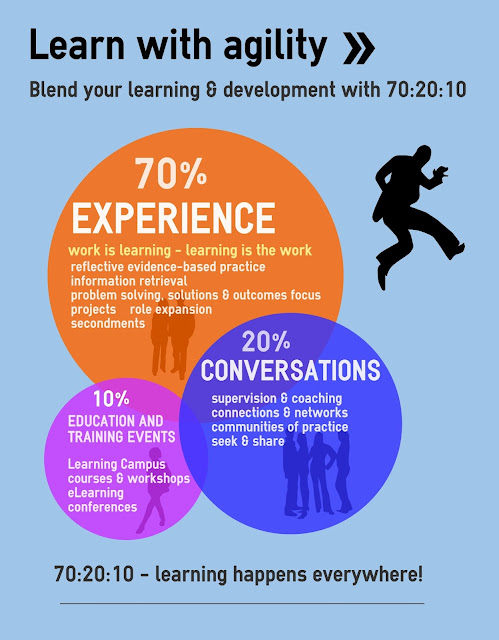Thursday 23 June 2016
Thursday 2 June 2016
Bridging the gap between our consumer technology experience and work
Increasingly, many of us are becoming tethered to our mobile devices and technology platforms in a sort of symbiotic relationship. The emerging Internet of Things is connecting people-people, people-things and things-things. This will have significant implications for the way we work and the way we support learning and performance at work.
Learning support at work, particularly for process or technical knowledge, should include an on-demand component. This enables people to pull learning to the point of need and means we don't need to store and recall information that is infrequently used. It also means we can free our cognitive load for higher level thinking and analysis. The use of digital 'knowledge centres', with powerful search engines, puts information and knowledge at our fingertips.
I often hear managers say - "but our people aren't tech savvy, this is the problem" - then why is it that these same people, are effortlessly navigating the web and using multimedia creatively on social platforms, in life outside of work?
As much as possible, we should be designing technology ecosystems at work that are consistent with our experience at home and beyond. Consumer technology puts people at the centre of design and uses stereotype design patterns to create an 'intuitive' experience. We generally shouldn't need to 'train' people in how to use our business systems if we design human/technology interfaces that reflect our consumer experience. A series of short, sharp videos and job aids can then provide targeted learning and performance support.
For remote workers in the field, mobile technology can augment learning and support performance. Recently I saw a hot water technician - probably an apprentice - taking photos and video footage to share with an experienced colleague for advice about a technical solution. This is just-in-time learning at its best. Interestingly I've often found our 'blue-collar' workforce to be much more innovative and willing to explore the use of technology for this purpose than office-based knowledge workers. Perhaps this has something to do with the degree of autonomy offered to field-based occupations.
On the topic of video and job aids, we're certainly in a visual age with most of us now consuming enormous amounts of video content outside of work. We're also seeing infographics become a ubiquitous medium for communication and marketing. So what does this mean for learning and performance in the workplace?
Over the last couple of years I've supported subject matter experts to create content to support an organisational shift to self-service technology. The screen capture tool - Snagit - has provided a low cost, easy-to-use platform for this purpose, with a video hosting solution. Interestingly, people become totally immersed in these projects when given an opportunity to extend the skills they regularly apply in their home lives with smartphone technology and Web 2.0 social media.
Part of the reinvention of learning and development in the workplace should be narrowing the technology gap between what we're doing with consumer technology outside work and our business technology ecosystem. Bridging this gap will enable us to truly mobilise our people as creators and curators of learning and performance content. Coupling this with a generous spirit of sharing, working out loud and collaboration, it becomes a powerful catalyst for continuous improvement and innovation.
After all, it's largely our people at the coalface who truly know what's needed to get the job done. So let's provide the tools, ignite their imagination and get out of the way.
Friday 22 April 2016
Less is more - communicating concepts visually
I haven't been doing much blogging in recent times, despite a lot of reflection and iterative thinking on-the-job.
Writing remains a significant focus around much of my work.
However I'm really trying to be more visual in the storytelling and ideas that I socialise.
Here's a sample of infographics I've created using easel.ly.
Subscribe to:
Posts (Atom)






